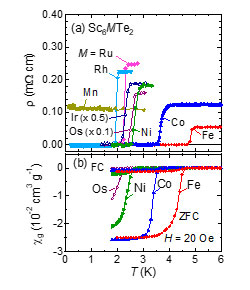PC-4-1-INV
Superconductivity in Ternary Telluride Sc6MTe2 with 3d, 4d, and 5d Transition Metals
16:45-17:15 28/11/2023
*Yoshihiko Okamoto
Institute for Solid State Physics, the University of Tokyo, Kashiwa 277-8581, Japan
d-electron superconductors, such as cuprates and iron arsenides, exhibited various unique superconductivities that have attracted attention in condensed matter physics. The d electrons of transition metals play a major role in the electrical properties of them and the cooperation between various features of d electrons results in the emergence of unique unconventional superconductivities. However, such d-electron superconductivities appeared only in materials with the specific combination of transition metal elements and crystal structure, which prevents complete understanding of them based on the systematic experimental studies.
Here we report the discovery of bulk superconductivity in Sc6MTe2, where M is Fe, Co, Ni, Ru, Rh, Os, and Ir. They crystallize in the hexagonal Zr6CoAl2type with the P−62 m space group [1,2]. The critical temperatures for M = 3 d elements were higher than those for M = 4 d and 5 d ones, as shown in the Figure, reaching the highest Tc = 4.7 K for M = Fe. First principles calculation results indicated the Fe 3 d electrons have considerable contribution to the electronic state at the Fermi energy. The upper critical field Hc2 also has a pronounced element dependence, where Sc6MTe2 with M = Os and Ir showed the high Hc2(0) violating the Pauli limit. These results clearly show that Sc6MTe2 is a unique d-electron superconductor family, in which d electrons of 3 d, 4 d, and 5 d M atoms strongly influence the superconducting properties.
[1] A. Maggard and J. D. Corbett, Inorg. Chem. 39, 4143 (2000).
[2] L. Chen and J. D. Corbett, Inorg. Chem. 43, 436 (2004).
[3] Y. Shinoda, Y. Okamoto, Y. Yamakawa, H. Matsumoto, D. Hirai, and K. Takenaka, J. Phys. Soc. Jpn., in press.
This work was done in collaboration with Y. Shinoda, Y. Yamakawa, D. Hirai, K. Takenaka (Nagoya Univ.) and H. Matsumoto, K. Yuchi (Univ. Tokyo).
